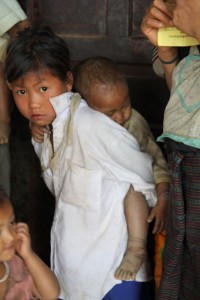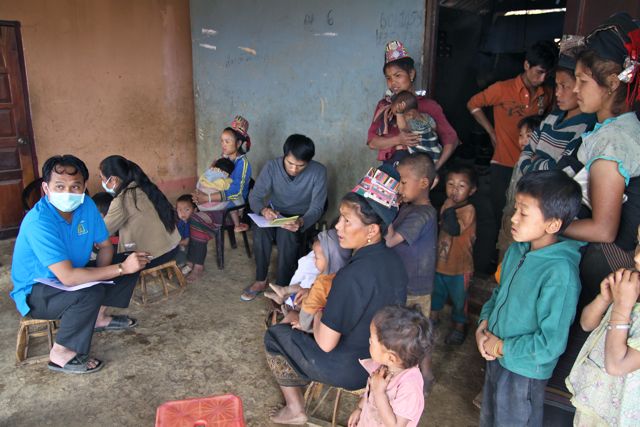Project Phongsali 2011: In response to our report of children’s deaths, doctors conduct an emergency clinic.
Day Thirty-Five:
As we passed through Kiew Ka Cham village this morning we noticed a pick-up truck with government plates sitting along the road. In the bed was a large white Styrofoam cooler, the kind that Lao venders use to transport meat, fish, vegetables and other perishable foods from market to village. When we stopped to snoop, I read a label on the cooler that suggested it contained vaccines.
I was thrilled with the site of that cooler, the first hard evidence that my overtures on behalf of the sick children in the village were heard in Vientiane and had moved someone to act. Yai and I immediately headed up the hill and into the village center to see what might be going on.
Sure enough, outside the naiban’s house four men wearing surgical masks sat among a crowd of concerned parents and sick children.
As Yai and I stood among the families one child after another, and often children in chorus, hacked and coughed. Some children cried in discomfort but most simply languished in a parent’s arms. Most every adult held a bright yellow card that I took to be the family’s immunization record.
The men, three doctors and a nurse, seemed very interested in the information shared by the parents, for each recorded copious notes in his journal. The doctors concluded each examination by swabbing the patient’s throat. I later learned that those cultures were sent by air to a lab in Vientiane.
What I most wanted to know was when this village might expect to receive vaccine sufficient to complete the immunization of all its children for common illnesses such as diphtheria, whooping cough, and measles. The doctors told me that although the village children were behind on immunizations, the immediate goal was to determine what specific virus had hit the village and claimed lives. Later, someone else would tackle broader issues.

Some parents had already left for work in the fields when the naiban announced the arrival of the doctors. Knowing that her brother was seriously ill, this little girl scooped him up and carried him to the clinic.
At the end of our workday the government truck was still parked along the road, so Yai and I stopped to ask the doctors how their day had gone; we found them packing up and preparing to depart on a four-hour drive to the airport in Oudomxai, with the objective of getting those throat cultures to Vientiane as quickly as possible.
In our final conversation the doctors confirmed my hunch that many children in the village were not properly immunized. The reasons they cited: poor record keeping, lack of parental support, low education, high illiteracy, shortage of vaccine, lack of proper refrigeration, and too much local trust in folk remedies and animist religious rites. Quite a list of challenges to overcome!


Let’s get Bill and Malinda Gates on board!!